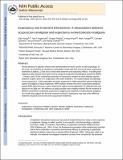Expectancy and Treatment Interactions: A Dissociation between Acupuncture Analgesia and Expectancy Evoked Placebo Analgesia
Author(s)
Kong, Jian; Kaptchuk, Ted J.; Polich, Ginger; Kirsch, Irving; Vangel, Mark G.; Zyloney, Carolyn; Rosen, Bruce R.; Gollub, Randy Lyanne; ... Show more Show less
DownloadKong_Expectancy and treatment.pdf (834.6Kb)
OPEN_ACCESS_POLICY
Open Access Policy
Creative Commons Attribution-Noncommercial-Share Alike
Terms of use
Metadata
Show full item recordAbstract
Recent advances in placebo research have demonstrated the mind's power to alter physiology. In this study, we combined an expectancy manipulation model with both verum and sham acupuncture treatments to address: 1) how and to what extent treatment and expectancy effects — including both subjective pain intensity levels (pain sensory ratings) and objective physiological activations (fMRI) — interact; and 2) if the underlying mechanism of expectancy remains the same whether placebo treatment is given alone or in conjunction with active treatment. The results indicate that although verum acupuncture + high expectation and sham acupuncture + high expectation induced subjective reports of analgesia of equal magnitude, fMRI analysis showed that verum acupuncture produced greater fMRI signal decrease in pain related brain regions during application of calibrated heat pain stimuli on the right arm. We believe our study provides brain imaging evidence for the existence of different mechanisms underlying acupuncture analgesia and expectancy evoked placebo analgesia. Our results also suggest that the brain network involved in expectancy may vary under different treatment situations (verum and sham acupuncture treatment).
Date issued
2008-12Department
Harvard University--MIT Division of Health Sciences and Technology; Massachusetts Institute of Technology. Department of Brain and Cognitive SciencesJournal
NeuroImage
Publisher
Elsevier
Citation
Kong, Jian et al. “Expectancy and Treatment Interactions: A Dissociation Between Acupuncture Analgesia and Expectancy Evoked Placebo Analgesia.” NeuroImage 45.3 (2009): 940–949.
Version: Author's final manuscript
ISSN
1053-8119
1095-9572